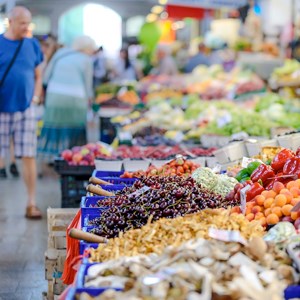Farmers market
Farmers market are food-oriented marketplaces organized regularly in a centrally located open-air or covered venue. Foodstuff traded are ‘locally produced’, which is either locally grown or incorporates locally grown ingredients (Holloway & Kneafsey 2000). Farmers market are traditional venues for commercial exchanges and negotiated meaning in the local food landscape (Smithers et al. 2008).
Main characteristics
- Open marketplace, where new customers can find new producers
- Face-to-face and personal communication between producers and consumers on a neutral ground
- Organized by third-party actors, often public or semi-public
- Transaction and pick-up take place simultaneously
- Takes places on a regular basis during harvest season thus facilitating seasonal food consumption
- Induces direct competition between peer producers, potentially framed through origin labelling
- Small volumes of each produce per customer
Box scheme
Box schemes offer a box of freshly picked vegetables and fruits or cut meat (fresh or frozen) from a local producer, delivered on a predetermined schedule either to a customer's door, to a convenient local drop off point or ready for pick up at the farm. A box scheme is usually operated by a sole producer, though sometimes together with other local producers as a collective. (adapted from Jones et al. 2004)
Main characteristics
- Operators offer various semi-bulk (large consumer volumes) options of different size and price-range
- Orders are placed days or weeks before delivery/pick-up, perhaps with pre-payment
- Boxes are marketed through e.g. mail lists, internet homepage, social media or through word-of-mouth (capillarity) & personal networks
- Pick-up/delivery schedule organized directly by the producer
- Whole-animal based boxes sells all cuts (for meat boxes); packed vegetable boxes can include selected variety, minimizing producer food waste
- May require large storage capacity for the producer (cooling chamber) and consumer (freezer)
REKO-RING
REKO collectives are open, non-noncommittal groupings of consumers and producers set up to bring consumers into contact with producers, facilitating the sale of foodstuff directly from producers to consumers in their locality. The contact is established and maintained via a dedicated Facebook member-group. For each scheduled pick-up date, the producer displays and prices the products available; consumers place orders directly with producers; with the producer and consumer then meeting at the designated pick-up for delivery. Most often pre-payment is required.
Main characteristics
- Each delivered item is pre-ordered.
- Marketing exclusively performed via the dedicated Facebook group
- No purchase obligation or participation fees for the members
- Use of electronic pre-payment
- Consumers can buy from multiple producers and pick-up at the same time/location
- Pick-up organized on a periodic (often bi-weekly or monthly) basis in a public outdoor location
Farm gate sales
Farm gate sales are product sales that are made at the farm. This channel may be structured very informally, with consumers arriving at the farm “anytime” and the product being packed on demand, or more structured, with specified “open hours” and pre-packed product assortment. As the structure continued to increase, the farm gate sales progress into a farm shop channel.
Main characteristics
- Can be highly informal, with little or no preparation by the producer
- Consumers visit the farm, with opportunity for social exchange and learning
- Often there is an existing relationship between the producer and the consumer
- Predominantly, small volume sales
- Can be inconvenient, with unstructured hours.
Farm shop
A farm shop is a permanent or semi-permanent facility on the farm where farm products, both fresh and processed (such as jams, honey and cheese) are offered for direct sale to visiting consumers. Shops are normally open to the public year-round or on scheduled openings, perhaps seasonal, in the evenings or week-ends. May be coupled with additional services, such light catering, collation, and tourism (adapted from Slocum & Curtis 2017).
Main characteristics
- Provides flexibility for the producer to set open hours
- May include off-farm products, providing consumers with broader assortment, and supporting the local/regional economy
- Necessitates on-farm investments to process and cool-store food and welcome the visitors
- Needs to abide to stringent food-hygiene regulations
- Possibility for consumers to visit the farm and experience farm-based livelihoods, sometimes developed into revenue-generating activities
- Learning site for pedagogy about agroecology
- Asset for regional agritourism
Community supported agriculture
Community Supported Agriculture is a direct partnership in which consumers (called members or shareholders) invest in a farm, for example by annual subscription and/or contribution of labour. In return, shareholders receive a proportion of the farm’s output, for example a weekly box of vegetables, and knowledge/experience from work-participation (Hinrichs 2000, Holloway et al. 2010). Farmers plan and do their best to produce sufficient quantities, quality, and variety of food products to meet their shareholders’ expectations (Galt 2013).
Main characteristics
- Production-shares sold upfront cover the yearly operating costs.
- Shared risks and rewards of production between producers and consumers
- Consumers may participate as on-farm workers
- Recreational and pedagogical benefit for participating shareholders
- Shareholders get seasonal produce from the harvest for a set price
- Allows producers to showcase their environmental stewardship practices and organic cultivation/breeding techniques
